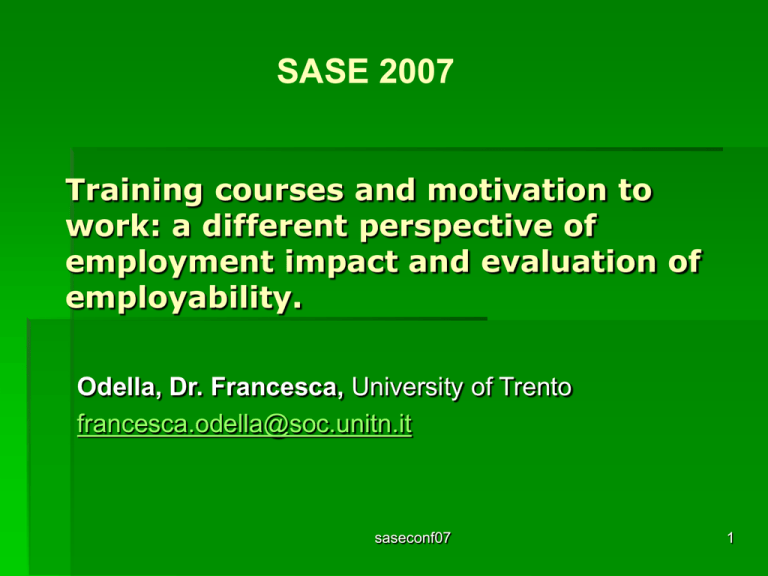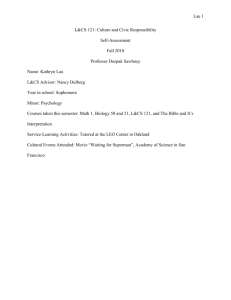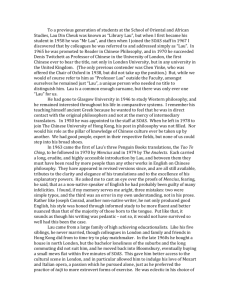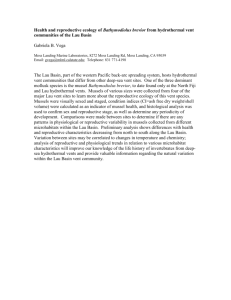Training courses and motivation to work: a different perspective of
advertisement

SASE 2007 Training courses and motivation to work: a different perspective of employment impact and evaluation of employability. Odella, Dr. Francesca, University of Trento francesca.odella@soc.unitn.it saseconf07 1 Characteristics of training at the firm level Training and motivation Motivation: social or individual trait? A case study in motivation and training courses Final observations: employability and motivation saseconf07 2 Characteristics of training at the firm level Germany Japan Italy Relevance of training Employment specific Career specific Task specific Core element Acquisition of skills Learning by doing Acquisition of knowledge Expected individual results Improvement of professional competence Sharing of experiences and competences Competence in action Links with production Preliminary and anticipated On the job e continuous Separate and dependant activity Long term Long term Short term Time prospective saseconf07 3 Motivation in training courses Training courses are developed with the aim to provide participants skills, knowledge and other elements of formal learning A preliminary experience of the work activity is also given by means of stages and other forms of participation to a real work setting/ organization Both these activities are supported and sustained by individual motivation (search for success, fear of failure, risk taking vs conformity traits). saseconf07 4 What is the role of motivation? Enhances learning processes (tasks and objectives) Support reward systems in organizations and groups Plays a role in innovation processes (individual/ group) Despite this relevance literature on motivation is more focused on children and adolescence learning; few research saseconf07 on adult people 5 Individual and social sources of motivation - I Origins of motivation are debated and specifically whether motivation is originate by individual trait or by social processes. The drive to act towards a specific objective can be explained as an individual need but the sources of this impulse can be various. In social psychology the search for the sources of motivation is related to the identification of preferences (Mc Clelland, 1953); different aspects of the personality can influence the performance and the effectiveness of learning. saseconf07 6 Individual and social sources of motivation -II The concept of level of aspiration is used to explain individual performance; and the difference between intrinsic and extrinsic motivation accounts for the type of relation that the individual tends to establish with the learning context. The interpersonal web of relations and the structure of the tasks in learning contexts is also linked with motivation and can reinforce as well as reduce its role. Organizational and group norms (from pure instrumental to moral involvement of members) are also elements that interfere either positively or negatively with individual motivation processes. saseconf07 7 Motivation in training courses Aim of the study: analyze the role of motivation in training courses -- Participants to training courses (European social funds) report an equal highly positive (95%) evaluation of training activity regardless of the employment status. Why this positive judgment? What is the role of individual motivation in influencing the effectiveness of training courses? Which role play the social aspects (organizational, group relationships)? Which elements of the learning context are more effective in providing participants a good training experience and can improve their employability? saseconf07 8 Impact of motivation on individual perception of employment status unemployed Training participant Positive evaluation employed Training courses Individual perception of training efficacy saseconf07 9 The design of the study Qualitative and in-depth study of a sample of participants to training courses one year after their experience. Sampling was based on one-year database of participants to European social funds courses (626) and take in account age, gender, educational level and type of courses attended. Selected subjects were 50 (25 male and 25 female) and a second equal characteristic sample was also prearranged. Interviewers were also trained on purpose to perform the colloquium and to collect information about impact of training courses on personal life of participants (time management, family impact, personal aspirations..). saseconf07 10 Gender and education rappresentativeness Vocational training 2 men women 6 University degree 5 5 High school degree 15 17 saseconf07 11 Analysis of interviews Multi-methods techniques (Brewer e Hunter, 1989) with qualitative coding of interviews (blind coding techniques), content analysis and quantitative analysis of text (Spad-T). Main area of investigation in the interviews were those specific aspects of motivation linked with (individually perceived ) impact of courses. The relationship between the structure of courses (content, learning context, organizational elements) and the impact on the trainee experience and motivation was also explored. saseconf07 12 Analysis of interviews Motivational aspects In the participants’ experience Effort Type of effort, organizational problems, time and family constraints, family and work situation Perception of training Relevance of training for prospective employers, availability of information, relevance on the job market Reasons to participate A – status achievement or B - improvement of personal situation at work Evaluation of the training activity Teachers, content of training, practical organization, formal and informal acquisition of skills Relationship between training and placement Status of trainee at the beginning of courses and at the end, self-evaluation of effectiveness saseconf07 13 Analysis of interviews Mapping of participants perception of the motivational aspects on the basis of education and gender differences; comparison of responses among groups, homogeneity and differences at individual level. Two axes (X frequency of aspect, Y relevance of aspect); Symbols: circle (univ. degree) square (vocational training), diamond (high school degree) Maps in the display: Reasons to participate, Evaluation of the training activity, Relationship between training and placement saseconf07 14 Reasons to participate (univ. degree, high scholl degree, vocational training) Ragioni della scelta 4,50 RILEVANZA DELLE CITAZIONI 4,00 3,50 3,00 2,50 2,00 1,50 1,00 0,50 0,00 0,00 1,00 2,00 3,00 4,00 5,00 6,00 FREQUENZA DELLE CITAZIONI saseconf07 15 Relationship between training and placement (univ. Degree – vocational training) RAPPORTO STATUS- PLACEMENT interviste ai laureati e qualificati 3,50 RILEVANZA DELLE CITAZIONI 3,00 2,50 2,00 1,50 1,00 0,50 0,00 0,00 1,00 2,00 3,00 4,00 5,00 6,00 7,00 8,00 FREQUENZA DELLE CITAZIONI lau_m1 lau_m 4 lau_m 6 lau_m 7 qual_m3 qual_m8 qual_f1 qual_f2 lau_f 2 lau_f 3 lau_f 5 lau_f 8 qual_f4 qual_f5 saseconf07 qual_f6 qual_f7 lau_f 9 16 Evaluation of the training activity (univ. Degree – vocational training) VALUTAZIONE DELLA FORMAZIONE interviste a laureati e qualificati 4,00 RILEVANZA DELLE CITAZIONI 3,50 3,00 2,50 2,00 1,50 1,00 0,50 0,00 0,00 1,00 2,00 3,00 4,00 5,00 6,00 7,00 8,00 9,00 10,00 FREQUENZA DELLE CITAZIONI lau_m1 lau_f 8 lau_m 4 qual_m8 lau_m 6 qual_f1 lau_m 7 qual_f4 lau_m 10 qual_f5 lau_f 2 qual_f6 saseconf07 lau_f 3 qual_f7 lau_f 5 lau_f 9 17 Synthesis of results Reasons to participate: Homogeneity of perception among educational groups Univ. Degree trainees emphasize the relevance of training for their career and are highly motivated in participating to a professional skills enhancing context; High school degree trainees have more variety of reasons and see training courses also as an opportunity to change type of work activity; while participants with a vocational degree evaluate the training experience as a crucial element in their career. Relationship between training and placement: Less homogeneity of responses among participants, gender and age play a crucial role. Only a limited group of Univ. and high school trainees have modified positively their aspiration level as a consequence of participating to the training activity. Motivation to improve professional condition (status) is linked to cultural preferences and self-perception of role in the labour market. Evaluation of training activities: educational level plays a role in the formation of two groups. First group (high school and vocational degrees) gives equal relevance to content and emotional aspects of training, while the second group (Univ. and high school degree) rewards more content specific activities. saseconf07 18 Final observations: Employability and motivation Organizational culture and systems of rewards can act as obstacles / incentives for individual motivation. Specifically practical experiences in training courses can be effective only if there is a balanced emphasis on individual motivation and is also supported by organizational elements (supervision, reporting, task and competence tracking) Employability of subjects is reinforced by motivational elements; motivation enhances competences and specific traits of the individual which are formally testified in training courses, it also give the subject self- perceptions of his/her capabilities and improves interactions at work and in the job market. Motivation can also be seen as a resource internal to the individual that can support phases of change at work and in lifecourse and more specifically social positioning of the individual towards the others. saseconf07 19 kudos The study was realized in 2004 as part of a wider project on the impact of training activities in the regional labour market of Trentino Alto Adige and was performed under the supervision of A.M. Ajello (University of Rome, Faculty of Psychology). I wish to thank the director of the ESF training division at PAT, the supervisor and the group of young researchers that performed and analyzed part of the interviews. saseconf07 20








